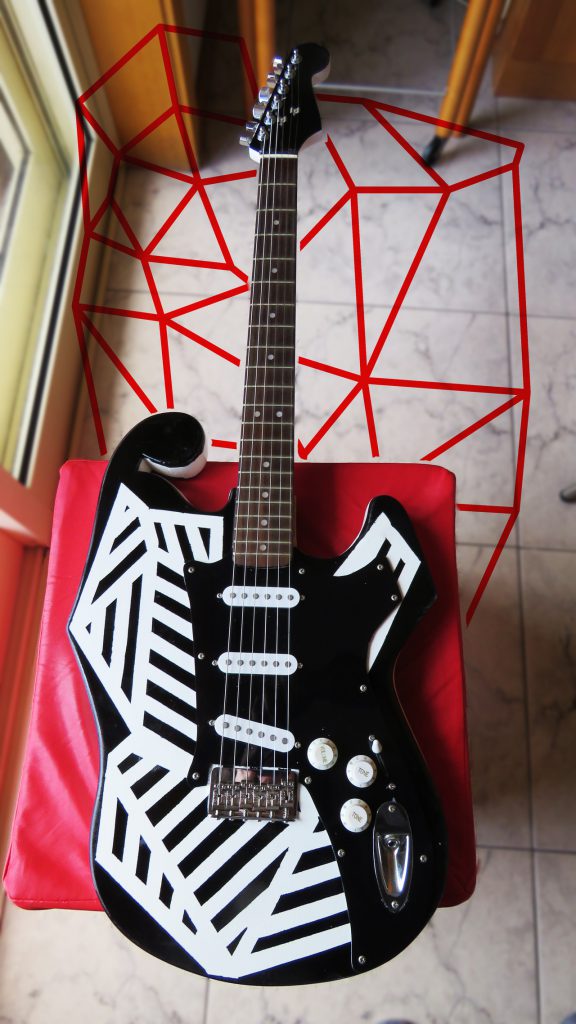Bit Strings
Gabriel Pinto
Bit Strings is the fruit of a life-long obsession with guitars I have, not just playing them but to always tweak, wreck them, and occasionally to piece them back together. Although I, in high school, had already built an electric guitar within a 5 person workgroup, it didn’t check all the quality boxes I thought essential for a quality go-to guitar.

And so I began to lay a blueprint of what could be achieved in Laboratório de Som e Imagem. I knew with time and work I could replicate almost every simple electric guitar, but I also wanted to add unique elements to make it a one of a kind, and to try to push the envelope in electric guitar’s design.

The real deal-makers I had in store to turn this into a unique instrument were the databending-guided original body design, Sol LeWitt’s wall drawings inspired paint scheme along with its instructions. I also knew that for this project the finished guitar had to have real-world quality, and by that I mean it had to compare favorably with mid- to end-range electric guitars in stores.
https://www.youtube.com/watch?v=q3FhyyMkrTE
As all music products/instruments/amplifiers are evolutions and not revolutions I started to produce several databent Fender Stratocaster’s bodies (in hopes of the final product be a one of a kind, but to the point of scaring away musicians). I found a compromise I was satisfied with, adding as well other musical elements into the design and adjusting some curves to make it ergonomic. I called this databending-guided design.
For the pickguard I wanted to make something I always asked myself about electric guitars and basses: why can’t the big brands make instruments’ electronics easy to remove and replace? It’s probably something to discourage tampering with the guitar, but that for me it’s something as essential for sound shaping as the strings used or the amplifier. The player should be able to easily change bits of the guitar to taste. So I made a big pickguard with all the pickups, the potentiometers, the switch and the jack. To remove the electronics it’s only required the user to unscrew some wood screws, no soldering required or anything.
The paint scheme was a variation of some ideas I had whilst doing some exercises for LSI, and as LeWitt’s wall drawings had a complete set of instructions. They were as follows:
- Draw a triangle;
- Draw quadrilaterals around the said triangle;
- Draw triangles where there is no triangles around.
- Repeat.
- When the picture/guitar is full or the person decides it’s enough, stop.
- Paint the geometric shapes using parallel lines of one of its borders in even intervals and using the same line thickness that was used in 1.
I was hoping to also work in some Processing program to serve as a digital interface between the guitar and the PC and do some sort of sound manipulation, but time constraints stopped that idea right in its tracks, but as all projects, and life itself, everything is a work-in-progress. Still, the guitar plays fine, sounds great and looks like no other!
Tools and materials
For the guitar I used basswood, which is a common wood used in musical instrument’s manufacturing. For all the wood work I used a portable jigsaw for cutting a rough guitar body, a lot of sandpaper, a not-so-stable drill and several cans of primer, paint and lacquer.
I used CorelDraw and Photoshop to draw all the guitar layout blueprints. For all my databending needs I used Adobe Audition, Audacity, Photoshop, and all the text and hex editing programs I could find.
Links
Gabriel António Monteiro Pinto (Porto, 1993) studies Biochemistry at the Faculdade de Ciências da Universidade do Porto (FCUP) and at Instituto de Ciências Biomédicas Abel Salazar (ICBAS). He also spends a lot of his time playing guitar.




